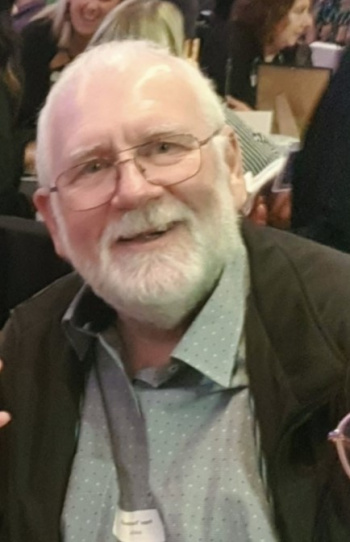
South Australian Science Teachers Association
Board Treasurer - Peter Turnbull
Posted by SASTA
on 17/06/2024

Peter Turnbull
School / Organisation: None- I am well retired! In my career I taught Science at Modbury HS, The Heights School, Valley View SS, Open Access College, and Urrbrae AHS. I was a Science Project and Curriculum officer with the education department for over 20 years, a role that included managing and developing the Science Equipment Scheme that provided the science teaching materials, chemicals and equipment to SA schools, and from where I became the go- to person for all matters relating to safety issues in science. Post retirement I taught science to university pre- service Primary teachers for a further 11 years until 2023.
Current role: My professional roles are now with SASTA- current Board Member, Treasurer and Oliphant Science Awards Convenor. I was Convenor of the CONASTA Conferences in Adelaide in both 2014 and in 2023.
What inspired you to become a science teacher? It was always on my list, but not my first choice as I had a short career for several years as a geologist before the end of a mining boom led me to become a science teacher. I was, as were very many students, inspired by a great teacher, in this case a teacher of science and geology in my high school years in a rural town in Queensland. He really inspired us as a group! Very much later I was able to connect with him again, and as is so often the case, he was totally unaware of and very much surprised by the enormous influence his enthusiastic approach had created for both me and my cohort at the time. His inspiration was huge! So teaching science was always an attractive choice. My family was, and still is, steeped in teachers!
How many years have you been teaching? Over 50 years.
Why did you join the SASTA Board? After many years on the fringes I wanted to contribute to SASTA so I joined the SASTA Board (then the SASTA Committee) in 1998. I have loved it, and have been a part of it ever since, except for my two terms on the ASTA executive (when I needed to resign from the SASTA Board for conflict of interest reasons). In my teaching career the professional associations have provided me with the greatest networking and professional learning opportunities I ever experienced, and by far!
Are there any other committees / organisations you are involved with? Not anymore. My other passionate hobby now is playing bridge which I do as often as I can. Apart from loving the game I justify this by regarding it as my hedge against dementia as I grow older. And I enjoy helping to teach the beginners to this very complicated game- the teacher has not left me.
If you could travel back in time and attend any scientific discovery or experiment in history, which one would it be, and why? I think that I may step outside of the main stream of thinking here, so I am not choosing Newton and his apple, or Fleming and Florey and penicillin, but going back to my background in geology. One big science concept is that of deep time, and that includes geological time and how it is understood and recorded. So I would like to go back to its development. I recently took my young grandchildren on a fossil hunt to Mannum, and where Popsy showed them where to find some marine fossils from the Murray Basin, echinoids, molluscs and brachiopods that are around 25 million years old, and which come from a time when all this was all covered by the ocean. Back in my high school years I was very fortunate to be given access to our local operating underground coal mine to collect Jurassic plant (fern) fossils from the mudstone that lay below the coal seam, at the age of 16!! The age of dinosaurs, around 150 million years old! So my topic of wonder is the understanding of geological time, and the development of stratigraphy and the time scale. Here in South Australia our rock record has many large gaps (not uncommon anywhere), but we do host some unique features. The jewel is the Ediacaran Period, the latest geological period to be defined, and the only one defined outside of Europe and North America. The type section is in the Flinders Ranges, and with the “Golden Spike” defining the start of the sequence in Brachina Gorge.
So my chosen discovery is about the science of stratigraphy and the understanding of geological time. My hero here is William Smith (1769- 1839). Smith was an engineer helping to build canals in England and Wales, and who in this work, uncovered many sedimentary layers and the different fossils that they contained. In making scientific sense of this he developed two laws that underpin the geological science of stratigraphy. The first law is that of superposition, that is, that in a sequence of strata, the older layers lie below and the newer layers lie above. His second law is that sedimentary strata are defined by the fossils that they contain. So strata of the same age should contain similar fossils. This work led to the construction of the geological time scale, to geological maps, and to an understanding of the relative ages of the rock units.
So if I could travel back in time I would like to have been with William Smith and studying the fossils that emerged as he dug his canals.
If you were to sum up your teaching philosophy in one sentence, what would it be? How many goes do I have here? Student centred, hands on, inquiry based, step outside of the four walls, repeat!
Archive
- July 2024
- June 2024
- May 2024
- April 2024
- March 2024
- February 2024
- December 2023
- November 2023
- October 2023
- September 2023
- August 2023
- July 2023
- June 2023
- May 2023
- April 2023
- March 2023
- February 2023
- January 2023
- December 2022
- November 2022
- October 2022
- September 2022
- August 2022
- July 2022
- June 2022
- May 2022
- April 2022
- March 2022
- February 2022
- January 2022
- December 2021
- November 2021
- October 2021
- September 2021
- August 2021
- July 2021
- June 2021
- May 2021
- April 2021
- March 2021
- February 2021
- January 2021
- December 2020
- November 2020
- October 2020
- September 2020
- August 2020
- July 2020
- June 2020
- May 2020
- April 2020
- October 2018
- September 2018
- August 2018
- July 2018
